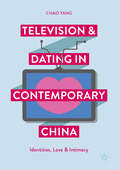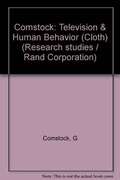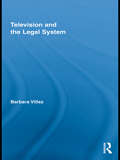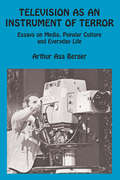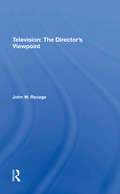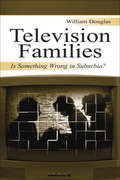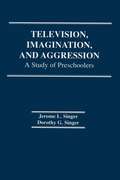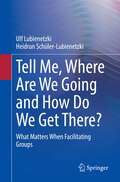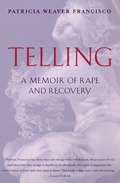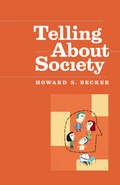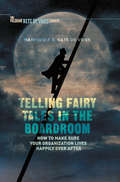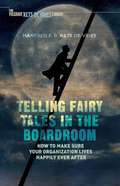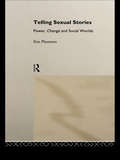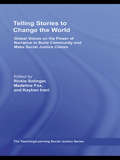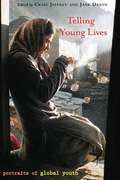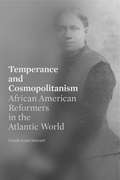- Table View
- List View
Television and Dating in Contemporary China
by Chao YangThis book considers the changing nature of intimacy in contemporary China, providing a unique case study of romantic subjectivities in young people in the world's fastest growing economy. Since the implementation of reform in 1978, the economic and socio-cultural environment of modern China has experienced a dramatic transformation under the influence of urbanization and globalization, facilitating more individualized identity among Chinese youth. This book bridges the gap between an emergent emphasis on individualisation and the country's traditional norms and values. It focuses on young people's understandings of various forms of relationships such as cohabitation, extramarital relationships and multiple relationships, suggesting a challenge to traditional familial values and an increasingly diversified understanding of the concepts of love and romance. By examining the formation of relationships among 21st century Chinese youth, notably through the lens of popular Chinese TV dating programs, this book considers how dating and relationships mirror China's changing societal structure and examines social and cultural transformations in Chinese society.
Television and Human Behavior
by George Comstock Steven Chaffee Nathan KatzmanStudies the impact of television on viewers' habits, activities, and attitudes, examining patterns of viewing, concepts that television imposes on public consciousness, and effects on children, blacks, and the poor
Television and the Legal System (Routledge Studies in Law, Society and Popular Culture)
by Barbara VillezThis book examines the American television legal series from its development as a genre in the 1940s to the present day. Villez demonstrates how the genre has been a rich source of legal information and understanding for Americans. These series have both informed and put myths in place about the legal system in the US. Villez also contrasts the US to France, which has seen a similar interest in legal series during this period. However, French television representations of justice are strikingly different, as is the role of fiction in offering viewers the possibility of acquiring significant understandings of their legal system. The book will be an important addition to the study of popular culture and law and will interest legal scholars, sociologists, and media scholars.
Television as an Instrument of Terror
by George SternliebThis volume explores the vast and endlessly growing subject of popular culture, mass culture, the public arts, and mass-mediated culture. They cover such varied forms of mass communication as television, the comics, advertising, humor, and fads, foods, and artifacts. Some of the essays have been published in such periodicals as Society magazine. Berger, widely recognized as a leading scholar in the field, continues to shape the thinking of today's scholars.
Television: The Director's Viewpoint
by John W. Ravage Jack RavageTelevision directors remain an enigma to most students of the mass media; traditionally, their function has been little understood by scholars and the viewing public. In this book, John Ravage studies the role of the director in the producer-dominated medium of commercial television. Built around lengthy interviews with twelve of the leading directors of commercial programs—representing all the genres of "prime time"—the book analyzes the major issues facing television, its past, present, and portents for the future, and the audience that watches it.
Television Families: Is Something Wrong in Suburbia? (Routledge Communication Series)
by William DouglasThis volume examines the analysis that was designed to map the development of the television family and assess its current state and, at the same time, to provide insight into the tangled relationships between fictional and real family life. In order to do this, the investigation examines the evolution of the American family, paying special attention to the postwar family, which is not only used recurrently as a benchmark for assessing the performance of modern families but also constituted television's first generation of families. The investigation also traces the evolution of the popular family in vaudeville, comics, and radio. However, the primary focus of the examination is the development of the television family, from families, such as the Nelsons, Andersons, and Cleavers, to more contemporary families, such as the Huxtables, Conners, and Taylors. The unit of analysis for the investigation is the relationship rather than the individual. Hence, the book deals with the portrayal of spousal, parent-child, and sibling relationships and how those portrayals differ across time and across groups defined by ethnicity, gender, and age. Moreover, the relational analysis is expansive so that television family relationships are examined in regard to power and affect, performance, and satisfaction and stability. Television Families provides a thorough summary and critical review of extant research, designed to promote informed classroom discussion. At the same time, it advances a number of hypotheses and recommendations and, as such, is intended to influence subsequent theory and research in the area. The book is intended for senior undergraduate students, graduate students, and television and family researchers.
Television, Imagination, and Aggression: A Study of Preschoolers
by D. G. SingerFirst Published in 1981. Routledge is an imprint of Taylor & Francis, an informa company.
Television in Society
by Arthur Asa BergerIs television a cultural wasteland, or a medium that has brought people more great art, music, dance, and drama than any previous media? How do we study and interpret television? What are the effects of television on individuals and society, and how do we measure them? What is the role of television in our political and economic life? Television in Society explores these issues in considering how television both reflects and affects society.The book is divided into two sections. The first focuses on programming and deals with commercials, ceremonial events, important series (such as ""MASH"" and ""Lou Grant""), significant programs (a production of Brave New World on television), and the images of police on the medium. The second part of the book deals with important issues and topics related to the medium: the impact of television violence, values found on television, the impact of television on education, the significance of new technological developments, and the always thorny issue of freedom of the press. The articles are drawn together by a brilliant introductory essay by Arthur Asa Berger, who examines television as culture.
Television in the Nursing Home: A Case Study of the Media Consumption Routines and Strategies of Nursing Home Residents
by Wendy J HajjarTelevision in the Nursing Home: A Case Study of the Media Consumption Routines and Strategies of Nursing Home Residents is a three-stage ethnographic study of media use by the elderly in long-term care facilities. This research concludes that watching television is the most prevalent and pervasive activity for patients. Activity directors can now learn how television and media can offer diversion, enhancement of personality, awareness, and sociability to their patients and offers suggestions on roommate coordination, selection of appropriate media, and communication resources. Containing the latest knowledge involving communication and gerontology, Television in the Nursing Home will help you offer programs that will meet the demands of an expanding elderly population.Developed as a perspective for examining patterns of social interaction, Television in the Nursing Home gives suggestions on how you can use the media to create new activities for patients, maximizing the television as a resource for the elderly. You will gain valuable insight on: proof to dispel the myth that television in long-term patient care causes withdrawal and depression a breakthrough in the treatment of media and aging, enhancing media-based activities and the use and purchase of electronic equipment for care facilities studies on how and why television is the most accessible medium of communication information for the development of new media designed specifically for use by the elderly creation of media-centered activities that recognize the potential for therapeutic use of communication technologies in the nursing homeThe research presented in Television in the Nursing Home establishes the fact that television consumption, once thought to be problematic, should be seen as desirable and necessary. This important book also proves how television is a resource that provides comfort, self-expression, and sociality. This first-ever study will convince you that television and media use in long-term care is beneficial and essential to the wellness of your patients.
Tell Me What You Want: The Science of Sexual Desire and How It Can Help You Improve Your Sex Life
by Justin J. LehmillerA leading expert on human sexuality and author of the blog Sex and Psychology offers an unprecedented look at sexual fantasy based on the most comprehensive, scientific survey ever undertaken. What do Americans really want when it comes to sex? And is it possible for us to get what we want? Justin J. Lehmiller, one of the country's leading experts on human sexuality and author of the popular blog Sex and Psychology, has made it his career's ambition to answer these questions. He recently concluded the largest and most comprehensive scientific survey of Americans' sexual fantasies ever undertaken, a monumental two-year study involving more than 4,000 Americans from all walks of life, answering questions of unusual scope. Based on this study, Tell Me What You Want offers an unprecedented look into our fantasy worlds and what they reveal about us. It helps readers to better understand their own sexual desires and how to attain them within their relationships, but also to appreciate why the desires of their partners may be so incredibly different. If we only better understood the incredible diversity of human sexual desire and why this diversity exists in the first place, we would experience less distress, anxiety, and shame about our own sexual fantasies and better understand why our partners often have sexual proclivities that are so different from our own. Ultimately, this book will help readers to enhance their sex lives and to maintain more satisfying relationships and marriages in the future by breaking down barriers to discussing sexual fantasies and allowing them to become a part of readers' sexual realities.
Tell Me, Where Are We Going and How Do We Get There?: What Matters When Facilitating Groups
by Ulf Lubienetzki Heidrun Schüler-LubienetzkiLearn the basics and techniques of a special form of conversation in this descriptive textbook: facilitation. Find out how facilitation supports communication and cooperation in groups and unleashes the potential existing in the group. This book is a translation of the original German 1st edition Sag mal: Wo geht’s lang und wie kommen wir dahin? by Ulf Lubienetzki & Heidrun Schüler-Lubienetzki, published by Springer-Verlag GmbH Germany, part of Springer Nature in 2020. The translation was done with the help of artificial intelligence (machine translation by the service DeepL.com). A subsequent human revision was done primarily in terms of content, so that the book will read stylistically differently from a conventional translation. Springer Nature works continuously to further the development of tools for the production of books and on the related technologies to support the authors.
Tell Tchaikovsky the News: Rock ’n’ Roll, the Labor Question, and the Musicians’ Union, 1942–1968
by Michael James RobertsFor two decades after rock music emerged in the 1940s, the American Federation of Musicians (AFM), the oldest and largest labor union representing professional musicians in the United States and Canada, refused to recognize rock 'n' roll as legitimate music or its performers as skilled musicians. The AFM never actively organized rock 'n' roll musicians, although recruiting them would have been in the union's economic interest. In Tell Tchaikovsky the News, Michael James Roberts argues that the reasons that the union failed to act in its own interest lay in its culture, in the opinions of its leadership and elite rank-and-file members. Explaining the bias of union members--most of whom were classical or jazz music performers--against rock music and musicians, Roberts addresses issues of race and class, questions of what qualified someone as a skilled or professional musician, and the threat that records, central to rock 'n' roll, posed to AFM members, who had long privileged live performances. Roberts contends that by rejecting rock 'n' rollers for two decades, the once formidable American Federation of Musicians lost their clout within the music industry.
Tell Them Who I Am
by Elliot LiebowHe observes them, creating portraits that are intimate and objective, while breaking down stereotypes and dehumanizing labels often used to describe the homeless. Liebow writes about their daily habits, constant struggles, their humor, compassion and strength.
Telling: A Memoir of Rape and Recovery
by Patricia Weaver FranciscoShe invites the reader into her life and into the questions raised by a crime with no obvious solutions or easy answers. We see the dimensions of a human struggle often kept hidden from view. While there are an estimated twelve million rape survivors in the United States, rape is still unspeakable, left out of our personal and cultural conversation. In Telling, Francisco has found a language for the secret grief carried by men and women who have survived rape.
Telling About Society (Chicago Guides To Writing, Editing, And Ser.)
by Howard S. BeckerI Remember, one of French writer Georges Perec’s most famous pieces, consists of 480 numbered paragraphs—each just a few short lines recalling a memory from his childhood. The work has neither a beginning nor an end. Nor does it contain any analysis. But it nonetheless reveals profound truths about French society during the 1940s and 50s. Taking Perec’s book as its cue, Telling About Society explores the unconventional ways we communicate what we know about society to others. The third in distinguished teacher Howard Becker’s best-selling series of writing guides for social scientists, the book explores the many ways knowledge about society can be shared and interpreted through different forms of telling—fiction, films, photographs, maps, even mathematical models—many of which remain outside the boundaries of conventional social science. Eight case studies, including the photographs of Walker Evans, the plays of George Bernard Shaw, the novels of Jane Austen and Italo Calvino, and the sociology of Erving Goffman, provide convincing support for Becker’s argument: that every way of telling about society is perfect—for some purpose. The trick is, as Becker notes, to discover what purpose is served by doing it this way rather than that. With Becker’s trademark humor and eminently practical advice, Telling About Society is an ideal guide for social scientists in all fields, for artists interested in saying something about society, and for anyone interested in communicating knowledge in unconventional ways.
Telling Fairy Tales in the Boardroom: How to Make Sure Your Organization Lives Happily Ever After (INSEAD Business Press)
by Manfred F.R. Kets de VriesWe know where we are with a fairy story. There is a cast of predictable characters, the hero or heroine is submitted to terrible trials, cruelty, and injustice but in the end the baddies get their comeuppance, good triumphs, and everyone lives happily ever after. In this book Manfred Kets de Vries, one of the world's leading authorities on the psychology of leadership, and a pioneering practitioner in the field of psychodynamic executive coaching, draws on the format of traditional fairy tales and tells us five stories that dramatize five key themes of dysfunctional leadership. The accompanying commentaries analyze each tale and examine the ways in which it applies to leadership behavior and organizational practices. This diagnostic element is supported by self-assessment tests that reinforce the main lessons of each tale and guide the reader's interpretation of the results. With Kets de Vries's guidance you'll be able to help your clients create best places to work, where everyone is the best they can be, and lives 'happily ever after'.
Telling Fairy Tales in the Boardroom: How to Make Sure Your Organization Lives Happily Ever After
by Manfred F. R. Kets de VriesWe know where we are with a fairy story. There is a cast of predictable characters, the hero or heroine is submitted to terrible trials, cruelty, and injustice but in the end the baddies get their comeuppance, good triumphs, and everyone lives happily ever after. In this book Manfred Kets de Vries, one of the world's leading authorities on the psychology of leadership, and a pioneering practitioner in the field of psychodynamic executive coaching, draws on the format of traditional fairy tales and tells us five stories that dramatize five key themes of dysfunctional leadership.
Telling Our Stories: The Lives of Latina Women (Latino Communities: Emerging Voices - Political, Social, Cultural and Legal Issues)
by Theresa Baron-McKeagneyStereotypes of Mexican American women and the lack of their representation in research literature contribute to misrepresentations of Mexican American culture and their invisibility. In this qualitative study, Mexican American women were interviewed and their life histories were examined using an ethnographic and hermeneutical phenomenological approach.
Telling Sexual Stories: Power, Change and Social Worlds
by Ken PlummerFirst published in 2004. Routledge is an imprint of Taylor & Francis, an informa company.
Telling Stories: The Use of Personal Narratives in the Social Sciences and History
by Mary Jo MaynesMary Jo Maynes, Jennifer L. Pierce, and Barbara Laslett argue that personal narratives--autobiographies, oral histories, life history interviews, and memoirs--are an important research tool for understanding the relationship between people and their societies. Gathering examples from throughout the world and from premodern as well as contemporary cultures, they draw from labor history and class analysis, feminist sociology, race relations, and anthropology to demonstrate the value of personal narratives for scholars and students alike. Telling Stories explores why and how personal narratives should be used as evidence, and the methods and pitfalls of their use. The authors stress the importance of recognizing that stories that people tell about their lives are never simply individual. Rather, they are told in historically specific times and settings and call on rules, models, and social experiences that govern how story elements link together in the process of self-narration. Stories show how individuals' motivations, emotions, and imaginations have been shaped by their cumulative life experiences. In turn, Telling Stories demonstrates how the knowledge produced by personal narrative analysis is not simply contained in the stories told; the understanding that takes place between narrator and analyst and between analyst and audience enriches the results immeasurably.
Telling Stories of Pain and Hope: Museums in South Africa and Ireland (ISSN)
by Ruth Teer-Tomaselli Mary Elizabeth LangeThe histories of South Africa and Ireland have been tumultuous and traumatic. Both countries have experienced political repression, sectarian violence and oppression that still impact the spiritual well-being of people today. Their parallel histories are of colonialism, displacement and division, and a fight for land and sovereignty. Both countries have embarked on a process of healing and reconciliation, yet there is an ongoing struggle for reparation and/or reversal of previous injustices.Recognising that museums of the 21st century have the potential to contribute to catharsis and mutual understanding, this book reflects on selected museums in South Africa and Ireland that commemorate the pain of the past and the hope for the future. The primary focus of the book is the way in which museum guides, curators and managers share their stories and the stories of their ancestors, and the stories of other people’s ancestors who were caught up in the conflict while interweaving the stories of the authors as well.Print edition not for sale in Sub Saharan Africa.
Telling Stories to Change the World: Global Voices on the Power of Narrative to Build Community and Make Social Justice Claims (Teaching/Learning Social Justice)
by Rickie Solinger Madeline Fox Kayhan IraniTelling Stories to Change the World is a powerful collection of essays about community-based and interest-based projects where storytelling is used as a strategy for speaking out for justice. Contributors from locations across the globe—including Uganda, Darfur, China, Afghanistan, South Africa, New Orleans, and Chicago—describe grassroots projects in which communities use narrative as a way of exploring what a more just society might look like and what civic engagement means. These compelling accounts of resistance, hope, and vision showcase the power of the storytelling form to generate critique and collective action. Together, these projects demonstrate the contemporary power of stories to stimulate engagement, active citizenship, the pride of identity, and the humility of human connectedness.
Telling Young Lives: Portraits of Global Youth
by Jane Dyson Craig JeffreyTelling Young Lives presents more than a dozen fascinating, ethnographically informed portraits of young people facing rapid changes in society and politics from different parts of the world. From a young woman engaged in agricultural labour in the High Himalayas to a youth activist based in Tanzania, the distinctive voices from the U. K. , India, Germany, Sierra Leone, South Africa and Bosnia Herzegovina, provide insights into the active and creative ways these youths are addressing social and political challenges such as war, hunger and homelessness. Telling Young Lives has great appeal for classroom use in geography courses and makes a welcome contribution to the growing field of "young geographies," as well as to politics and political geography. Its focus on individual portraits gives readers a fuller, more vivid picture of the ways in which global changes are reshaping the actual experiences and strategies of young people around the world.
Temperance and Cosmopolitanism: African American Reformers in the Atlantic World (Africana Religions #1)
by Carole Lynn StewartTemperance and Cosmopolitanism explores the nature and meaning of cosmopolitan freedom in the nineteenth century through a study of selected African American authors and reformers: William Wells Brown, Martin Delany, George Moses Horton, Frances E. W. Harper, and Amanda Berry Smith. Their voluntary travels, a reversal of the involuntary movement of enslavement, form the basis for a critical mode of cosmopolitan freedom rooted in temperance. Both before and after the Civil War, white Americans often associated alcohol and drugs with blackness and enslavement. Carole Lynn Stewart traces how African American reformers mobilized the discourses of cosmopolitanism and restraint to expand the meaning of freedom—a freedom that draws on themes of abolitionism and temperance not only as principles and practices for the inner life but simultaneously as the ordering structures for forms of culture and society. While investigating traditional meanings of temperance consistent with the ethos of the Protestant work ethic, Enlightenment rationality, or asceticism, Stewart shows how temperance informed the founding of diasporic communities and civil societies to heal those who had been affected by the pursuit of excess in the transatlantic slave trade and the individualist pursuit of happiness. By elucidating the concept of the “black Atlantic” through the lenses of literary reformers, Temperance and Cosmopolitanism challenges the narrative of Atlantic history, empire, and European elite cosmopolitanism. Its interdisciplinary approach will be of particular value to scholars of African American literature and history as well as scholars of nineteenth-century cultural, political, and religious studies.
Temperance and Cosmopolitanism: African American Reformers in the Atlantic World (Africana Religions)
by Carole Lynn StewartTemperance and Cosmopolitanism explores the nature and meaning of cosmopolitan freedom in the nineteenth century through a study of selected African American authors and reformers: William Wells Brown, Martin Delany, George Moses Horton, Frances E. W. Harper, and Amanda Berry Smith. Their voluntary travels, a reversal of the involuntary movement of enslavement, form the basis for a critical mode of cosmopolitan freedom rooted in temperance. Both before and after the Civil War, white Americans often associated alcohol and drugs with blackness and enslavement. Carole Lynn Stewart traces how African American reformers mobilized the discourses of cosmopolitanism and restraint to expand the meaning of freedom—a freedom that draws on themes of abolitionism and temperance not only as principles and practices for the inner life but simultaneously as the ordering structures for forms of culture and society. While investigating traditional meanings of temperance consistent with the ethos of the Protestant work ethic, Enlightenment rationality, or asceticism, Stewart shows how temperance informed the founding of diasporic communities and civil societies to heal those who had been affected by the pursuit of excess in the transatlantic slave trade and the individualist pursuit of happiness. By elucidating the concept of the “black Atlantic” through the lenses of literary reformers, Temperance and Cosmopolitanism challenges the narrative of Atlantic history, empire, and European elite cosmopolitanism. Its interdisciplinary approach will be of particular value to scholars of African American literature and history as well as scholars of nineteenth-century cultural, political, and religious studies.
